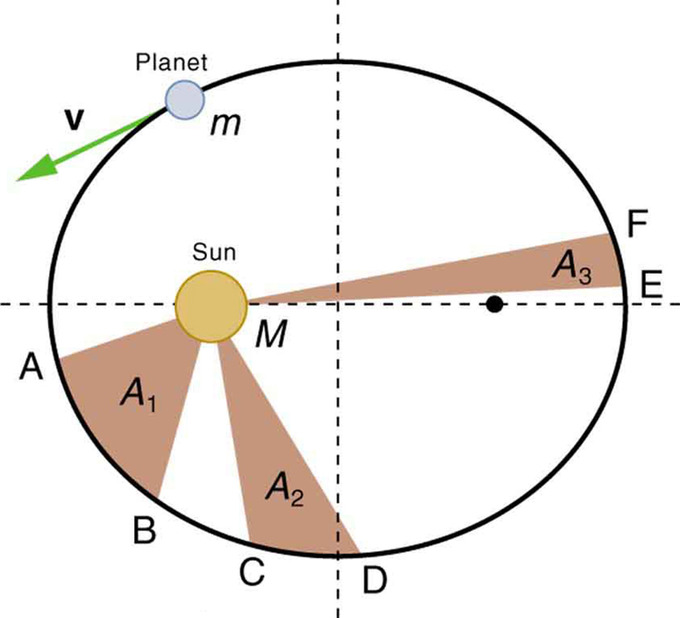]
Dynamics of UCM
Newton’s universal law of gravitation states that every particle attracts every other particle with a force along a line joining them.
Learning Objectives
Relate Kepler’s laws to Newton’s universal law of gravitation
Key Takeaways
Key Points
- The gravitational force is directly proportional to the product of their masses and inversely proportional to the square of the distance between them.
- Kepler discovered laws describing planetary motion long before the days of Newton, purely based on the observations of Tycho Brahe.
- Kepler’s laws can be derived from the Newton’s universal law of gravitation and his equation of motion.
Key Terms
- asteroid: A naturally occurring solid object, which is smaller than a planet and is not a comet, that orbits a star.
- planet: A large body which directly orbits any star (or star cluster) but which has not attained nuclear fusion.
Newton’s Universal Law of Gravitation
Newton’s universal law of gravitation states that every particle in the universe attracts every other particle with a force along a line joining them. The force is directly proportional to the product of their masses and inversely proportional to the square of the distance between them. For two bodies having masses [latex]\text{m}[/latex] and [latex]\text{M}[/latex] with a distance [latex]\text{r}[/latex] between their centers of mass, the equation for Newton’s universal law of gravitation is:
[latex]\displaystyle \text{F} = \text{G}\frac{\text{mM}}{\text{r}^2}[/latex]
The gravitational force is responsible for artificial satellites orbiting the Earth. The Moon’s orbit about Earth, the orbits of planets, asteroids, meteors, and comets about the Sun are other examples of gravitational orbits. Historically, Kepler discovered his 3 laws (called Kepler’s law of planetary motion) long before the days of Newton. Kepler devised his laws after careful study (over some 20 years) of a large amount of meticulously recorded observations of planetary motion done by Tycho Brahe (1546–1601).
Kepler’s Laws
- The orbit of each planet about the Sun is an ellipse with the Sun at one focus.
- Each planet moves so that an imaginary line drawn from the Sun to the planet sweeps out equal areas in equal times.
- The ratio of the squares of the periods of any two planets about the Sun is equal to the ratio of the cubes of their average distances from the Sun.

Kepler’s Second Law: The shaded regions have equal areas. It takes equal times for [latex]\text{m}[/latex] to go from [latex]\text{A}[/latex] to [latex]\text{B}[/latex], from [latex]\text{C}[/latex] to [latex]\text{D}[/latex], and from [latex]\text{E}[/latex] to [latex]\text{F}[/latex]. The mass [latex]\text{m}[/latex] moves fastest when it is closest to [latex]\text{M}[/latex]. Kepler’s second law was originally devised for planets orbiting the Sun, but it has broader validity.
Ellipses and Kepler’s First Law: (a) An ellipse is a closed curve such that the sum of the distances from a point on the curve to the two foci ([latex]\text{f}_1[/latex] and [latex]\text{f}_2[/latex]) is a constant. You can draw an ellipse as shown by putting a pin at each focus, and then placing a string around a pencil and the pins and tracing a line on paper. A circle is a special case of an ellipse in which the two foci coincide (thus any point on the circle is the same distance from the center). (b) For any closed gravitational orbit, [latex]\text{m}[/latex] follows an elliptical path with [latex]\text{M}[/latex] at one focus. Kepler’s first law states this fact for planets orbiting the Sun.
Candela Citations
- Curation and Revision. Provided by: Boundless.com. License: CC BY-SA: Attribution-ShareAlike
- OpenStax College, College Physics. September 17, 2013. Provided by: OpenStax CNX. Located at: http://cnx.org/content/m42083/latest/?collection=col11406/1.7. License: CC BY: Attribution
- OpenStax College, College Physics. September 17, 2013. Provided by: OpenStax CNX. Located at: http://cnx.org/content/m42084/latest/?collection=col11406/1.7. License: CC BY: Attribution
- OpenStax College, College Physics. September 17, 2013. Provided by: OpenStax CNX. Located at: http://cnx.org/content/m42086/latest/?collection=col11406/1.7. License: CC BY: Attribution
- OpenStax College, College Physics. September 17, 2013. Provided by: OpenStax CNX. Located at: http://cnx.org/content/m42083/latest/?collection=col11406/1.7. License: CC BY: Attribution
- centripetal. Provided by: Wiktionary. Located at: http://en.wiktionary.org/wiki/centripetal. License: CC BY-SA: Attribution-ShareAlike
- OpenStax College, College Physics. January 16, 2015. Provided by: OpenStax CNX. Located at: http://cnx.org/content/m42083/latest/?collection=col11406/1.7. License: CC BY: Attribution
- OpenStax College, College Physics. September 17, 2013. Provided by: OpenStax CNX. Located at: http://cnx.org/content/m42143/latest/?collection=col11406/1.7. License: CC BY: Attribution
- OpenStax College, College Physics. September 17, 2013. Provided by: OpenStax CNX. Located at: http://cnx.org/content/m42144/latest/?collection=col11406/1.7. License: CC BY: Attribution
- planet. Provided by: Wiktionary. Located at: http://en.wiktionary.org/wiki/planet. License: CC BY-SA: Attribution-ShareAlike
- asteroid. Provided by: Wiktionary. Located at: http://en.wiktionary.org/wiki/asteroid. License: CC BY-SA: Attribution-ShareAlike
- OpenStax College, College Physics. January 16, 2015. Provided by: OpenStax CNX. Located at: http://cnx.org/content/m42083/latest/?collection=col11406/1.7. License: CC BY: Attribution
- OpenStax College, College Physics. January 28, 2013. Provided by: OpenStax CNX. Located at: http://cnx.org/content/m42144/latest/?collection=col11406/1.7. License: CC BY: Attribution
- OpenStax College, College Physics. January 28, 2013. Provided by: OpenStax CNX. Located at: http://cnx.org/content/m42144/latest/?collection=col11406/1.7. License: CC BY: Attribution
- OpenStax College, College Physics. September 17, 2013. Provided by: OpenStax CNX. Located at: http://cnx.org/content/m42086/latest/?collection=col11406/1.7. License: CC BY: Attribution
- centripetal. Provided by: Wiktionary. Located at: http://en.wiktionary.org/wiki/centripetal. License: CC BY-SA: Attribution-ShareAlike
- normal force. Provided by: Wiktionary. Located at: http://en.wiktionary.org/wiki/normal_force. License: CC BY-SA: Attribution-ShareAlike
- OpenStax College, College Physics. January 16, 2015. Provided by: OpenStax CNX. Located at: http://cnx.org/content/m42083/latest/?collection=col11406/1.7. License: CC BY: Attribution
- OpenStax College, College Physics. January 28, 2013. Provided by: OpenStax CNX. Located at: http://cnx.org/content/m42144/latest/?collection=col11406/1.7. License: CC BY: Attribution
- OpenStax College, College Physics. January 28, 2013. Provided by: OpenStax CNX. Located at: http://cnx.org/content/m42144/latest/?collection=col11406/1.7. License: CC BY: Attribution
- OpenStax College, College Physics. February 6, 2013. Provided by: OpenStax CNX. Located at: http://cnx.org/content/m42086/latest/?collection=col11406/1.7. License: CC BY: Attribution

